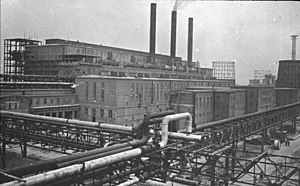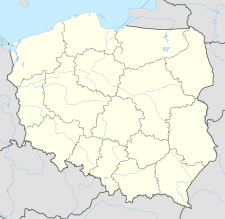Monowitz
| Monowitz Buna-Werke | |
|---|---|
| Concentration camp | |

IG Farben factory within the Auschwitz III camp complex
|
|
| Coordinates | 50°01′39″N 19°17′17″E / 50.02750°N 19.28806°ECoordinates: 50°01′39″N 19°17′17″E / 50.02750°N 19.28806°E |
| Other names | Monowitz (placename) |
| Known for | Forced labor camp |
| Location | Near Oświęcim, Polish areas annexed by Nazi Germany |
| Built by | IG Farben |
| Operated by | Schutzstaffel |
| Original use | Factories for producing synthetic rubber and chemicals including Zyklon B |
| First built | October 1942 |
| Operational | October 1942 - January 1945 |
| Inmates | Mainly Jews |
| Number of inmates | Around 12,000 |
| Liberated by | Red Army on January 27, 1945. |
| Notable inmates | Primo Levi, Victor Perez, Elie Wiesel |
Monowitz (also called Monowitz-Buna or Auschwitz III) was initially established as a subcamp of Nazi Germany's Auschwitz concentration camp. It was one of the three main camps in the Auschwitz concentration camp system, with an additional 45 subcamps in the surrounding area. It was named after the village of Monowice (German: Monowitz) upon which it was built and was located in the annexed portion of Poland. The SS established the camp in October 1942 at the behest of I.G. Farben executives to provide slave labor for their Buna Werke (Buna Works) industrial complex. The name Buna was derived from the butadiene-based synthetic rubber and the chemical symbol for sodium (Na), a process of synthetic rubber production developed in Germany. Various other German industrial enterprises built factories with their own subcamps, such as Siemens-Schuckert's Bobrek subcamp, close to Monowitz in order to profit from the use of slave labor. The German armaments manufacturer Krupp, headed by SS member Alfried Krupp, also built their own manufacturing facilities near Monowitz.
Monowitz was built as an Arbeitslager (workcamp); it also contained an "Arbeitsausbildungslager" (Labor Education Camp) for non-Jewish prisoners perceived not up to par with German work standards. It held approximately 12,000 prisoners, the great majority of whom were Jewish, in addition to non-Jewish criminals and political prisoners. Prisoners from Monowitz were leased out by the SS to IG Farben to labor at the Buna Werke, a collection of chemical factories including those used to manufacture Buna (synthetic rubber) and synthetic oil. The SS charged IG Farben three Reichsmarks (RM) per day for unskilled workers, four (RM) per hour for skilled workers, and one and one-half (RM) for children.
...
Wikipedia

